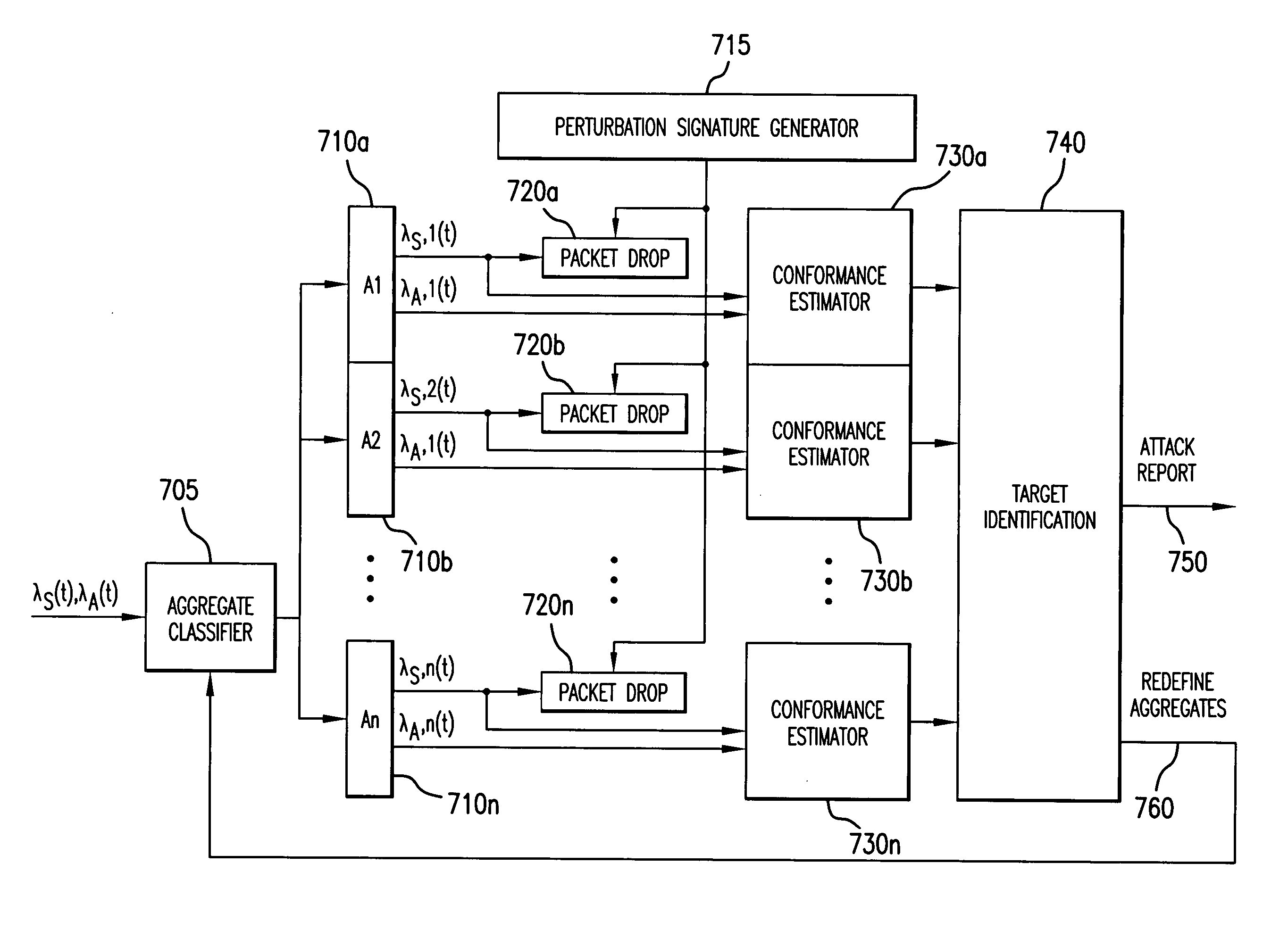Detection of nonconforming network traffic flow aggregates for mitigating distributed denial of service attacks
a network traffic and aggregate technology, applied in the field of detection of nonconform network traffic flow aggregates for mitigating distributed denial of service attacks, can solve the problems of many bins overloaded, erroneous measurements, and prohibitive ddos application limitations
- Summary
- Abstract
- Description
- Claims
- Application Information
AI Technical Summary
Problems solved by technology
Method used
Image
Examples
case 1
[0053] Case 1: In the first case, no nonconforming SYN packets exist in the aggregate, and both the SYN rate and the ACK rate are received at approximately 10,000 packets per second when there is no perturbation. When the perturbation is applied, the ACK rate decreases to λA(t)=9900 packets per second. The difference between the SYN arrival rate and the ACK arrival rate is illustrated in FIG. 5A. The waveform of FIG. 5A, when integrated, produces the expected nominal value of the matched filter output as α=100.
case 2
[0054] Case 2: In this case, 40 percent of the SYN packets are nonconforming and are not followed up in the three-way handshake by a corresponding ACK packet. The difference between the SYN arrival rate and the ACK arrival rate in this case is illustrated in FIG. 5B. The arrival rate of ACK packets is 6,000 when the traffic is not perturbed and is 5,940 packets per second when 100 packets per second are randomly dropped. That is, from the 100 per second dropped SYN packets during the perturbation, only 60 packets per second correspond to the conforming SYNs, and the other 40 packets per second are not followed by ACK packets in the three-way handshake. The matched filter output in this case reduces to 60, which, when subtracted from the expected nominal value of α=100, indicates a 40 percent deviation.
case 3
[0055] Case 3: In the final case, 40 percent of SYNs are followed by blindly transmitted ACK packets. The other 60 percent is composed of legitimate SYN packets. In this case, if no SYN packets are dropped, 10,000 ACK packets per second will be observed, and in the intervals when SYN packets are dropped, 9940 ACKs per second will be observed. That is, from 100 per second packet drops during the test, 40 of ACK packets are sent regardless of the server response. In this case, the output of matched filter is 60 again, and similar to the previous case, the matched filter output estimates 40 percent nonconforming traffic. This case is illustrated in FIG. 5C.
[0056] The numerical examples described above show that blind transmissions of ACKs cannot mislead the modified CAPM in detecting nonconforming SYN packets. When blind ACK packets are sent, they are not aligned with the perturbation signature and are thus received in a manner that is inconsistent with the protocol as conditioned by t...
PUM
 Login to View More
Login to View More Abstract
Description
Claims
Application Information
 Login to View More
Login to View More - R&D
- Intellectual Property
- Life Sciences
- Materials
- Tech Scout
- Unparalleled Data Quality
- Higher Quality Content
- 60% Fewer Hallucinations
Browse by: Latest US Patents, China's latest patents, Technical Efficacy Thesaurus, Application Domain, Technology Topic, Popular Technical Reports.
© 2025 PatSnap. All rights reserved.Legal|Privacy policy|Modern Slavery Act Transparency Statement|Sitemap|About US| Contact US: help@patsnap.com



